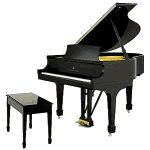

Composers from Amazon.com's Get Started in Classical:
| Bach | Glass | Schubert |
| Beethoven | Mahler | Stravinsky |
| Copland | Mozart | Tilson Thomas |
| Corigliano | Mutter | Wagner |
| Debussy | Pärt | Zimerman |
| NEW! Huang Additional composers and musicians |
||
Arvo Pärt
This is from Amazon.com's Get Started in Classical.
Pärt's unique brand of spiritually intense minimalism
The umbrella term "minimalism" is generally used to cover one of the most noteworthy developments in classical music of the last 30 years. But Estonian composer Arvo Pärt (b. 1935) arrived at his serene version of this aesthetic through a path entirely different from that of minimalism's best-known American exponents, Philip Glass and Steve Reich. While composers in the West were rebelling against the postwar academic orthodoxy then dominant and attempting to find a more immediately communicative kind of musical expression, Pärt's early work embraced a harsh serialist idiom as his own form of rebellion against the official Soviet straightjacket of "Socialist realism." Pärt's immersion in the religious traditions of the Orthodox Church and study of medieval choral music eventually led to a dramatic transformation of his style. His dark-hued, melancholy Third Symphony from 1971, for example, synthesizes the influence of Shostakovich with an archaic resonance drawn from chant.
But it is with the works on Tabula Rasa--composed in the mid-'70s--that Pärt achieved a breakthrough to his immediately recognizable style of a spartan but pregnant simplicity. Its immense popularity paved the way for the success of Pärt's similar-minded European colleagues John Tavener and Henryk Grecki, who together are often classified as "holy minimalists" because of the spiritual preoccupation of their music. Here the acoustically vivid production of ECM's Manfred Eicher is perfectly wedded to Pärt's contemplative, hypnotic intensity. The repetitive textures of the music seem like a mantra that washes the listener's consciousness free from distraction, inevitably centering it on the paradoxical timelessness of the present.
Take the ever-returning chantlike sequence of the opening track, Fratres (Latin for "brothers"), for example. Whether in the violin's first flurrying figurations or in the piece's luminous slow passages, with their cadences left to drift into thin air (punctuated by a mysterious knell in the piano's bass), this music thwarts the Western expectation of linear development. Instead, its quasimonastic solemnity conveys an impression of stasis in motion. At times, Gidon Kremer blends the violin part as if it were an ethereal strain let loose from pianist Keith Jarrett's spare chords, while elsewhere he gives emphasis to the two instruments' contrasting sonorities. Listen to the hair-thin notes of his ghostly higher register as the violin hovers above, a marvelous illustration of the intense, mysteriously distant austerity so central to Part's music. And yet for all its simplicity, there's an inner richness to this music that becomes particularly apparent when you listen to the markedly different experience it arouses in the version included here for 12 cellos. Intermittent beats of percussion (in place of the piano chords mentioned above) suggest some ancient, deeply significant processional.
Cantus in memory of Benjamin Britten is one of Pärt's most hauntingly memorable pieces. It's also a brilliant example of the composer's ability to intensify and heighten his music's emotional content through the simplest of means. Against tolling tubular bells, a string orchestra plays nothing but a descending minor scale--simultaneously at varying speeds. And yet the effect of this threnody is overwhelming, right through the immense final chord that won't seem to let us free from its grip. In Cantus, you'll also notice Pärt's hallmark fascination with what he calls "tintinnabulation"--that is, both the literal and metaphorical sound (as in an insistently repeated single chord) of ringing bells.
The disc's title work, Tabula Rasa, is the longest, strategically placed at the end so that you can become familiar with the composer's idiom through the shorter preceding pieces. But even if you plunge straight into Tabula Rasa, you'll likely find it a piece of extraordinarily mesmerizing, strange beauty. Written for Gidon Kremer, it is scored for two violins, string orchestra, and prepared piano, which creates a strikingly novel effect clanging from below against Kremer's soaring violin. The work can be seen as a sort of epitome of Pärt's mystical simplicity--you'll hear such elements as the tintinnabulation and even the sad descending scale from Cantus described above. Notice too the incantatory quality Kremer conveys with his violin, which in the second, slower section comes amazingly close to a pleading human voice.
Thomas May, Classical Editor
More Pärt can be found in can be found in Musical Information.
O'Connor Music Studio Recommendations
lists Books, CD's, Cassette Tapes, Computer Programs, Music Scores DVD's, Videos and more
from amazon.com, as well as several other sources.
 If you are looking for ideas for children's books, cd's, cassette tapes, computer
programs, games and toys, click here for some ideas.
If you are looking for ideas for children's books, cd's, cassette tapes, computer
programs, games and toys, click here for some ideas.
Many thanks to Dearest for everything!
is located
in Fairfax, Virginia
Over 30 Years
~~
Piano, Organ
Electric Keyboard
Accompanying
Email Mary O'Connor
All rights reserved.
Site design and maintenance by
O'Connor O'Riginals Web Design